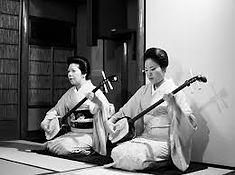
Arthur Golden's
Memoirs of a Geisha
Geisha: the "gei" in geisha means "art". Therefore, geisha translates as "artisan" or "artist.
"She paints her face to hide her face. Her eyes are deep water. It is not for Geisha to want. It is not for geisha to feel. Geisha is an artist of the floating world. She dances, she sings. She entertains you, whatever you want. The rest is shadows, the rest is secret.”


Two Types of Geisha
-
Tachikata (mainly dances)
-
Jikata (mainly sings and/or plays instruments)

Training
-
Shikomi: put to work as maid or slave. Do whatever one is told. Wait on the senior geishas of the okiya. Meanwhile, attend the hanamachi geisha school
-
Minaral: relieved of maid duties. Continue to attend school. Taken under the wing of an “older sister” (onee-san). Follows older sister to her events and mainly observes and pours tea (seen, not heard). Clothing in this stage is the most expressive and impressive (clothing is meant to speak for them).
-
Maiko: Apprentice geisha. This stage last years. Goes with older sister everywhere and may now participate. Older sister will help pick new professional name. Maiko’s virginity is auctioned to the highest bidder (mizuage).
*Once the older sister is confident, the maiko becomes a true geisha (geiko)*



A true Geisha learns:
-
tea ceremony
-
flower arrangement
-
calligraphy
-
to play the shaman (a three stringed instrument)
-
dancing
-
the art of conversation
Fun Fact
Fiona Graham is the first ever non-japanese women in 400 years to be accepted into the ranks of Geisha. She now works in Tokyo under her new name Sayuki.
Learn more about her story by clicking the blue button